Stuffed (7)
By:
May 6, 2015
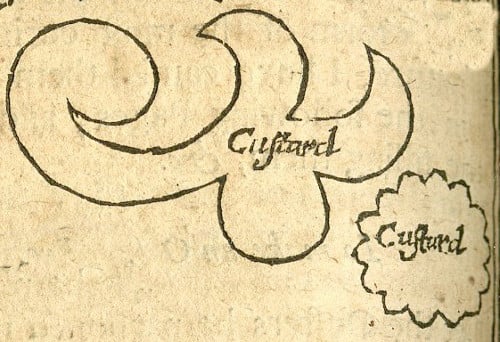
One in a new series of posts by Tom Nealon, author of the highly popular 2010–2012 HiLobrow series DE CONDIMENTIS. The posts in the STUFFED series are inspired by Nealon’s collection of rare cookbooks, which he sells — among other things — via Pazzo Books. His rare cookbook catalog is available here as a PDF or a full color book.
STUFFED SERIES: THE MAGAZINE OF TASTE | AUGURIES AND PIGNOSTICATIONS | THE CATSUP WAR | CAVEAT CONDIMENTOR | CURRIE CONDIMENTO | POTATO CHIPS AND DEMOCRACY | PIE SHAPES | WHEY AND WHEY NOT | PINK LEMONADE | EUREKA! MICROWAVES | CULINARY ILLUSIONS | AD SALSA PER ASPERA | THE WAR ON MOLE | ALMONDS: NO JOY | GARNISHED | REVUE DES MENUS | REVUE DES MENUS (DEUX) | WORCESTERSHIRE SAUCE | THE THICKENING | TRUMPED | CHILES EN MOVIMIENTO | THE GREAT EATER OF KENT | GETTING MEDIEVAL WITH CHEF WATSON | KETCHUP & DIJON | TRY THE SCROD | MOCK VENISON | THE ROMANCE OF BUTCHERY | I CAN HAZ YOUR TACOS | STUFFED TURKEY | BREAKING GINGERBREAD | WHO ATE WHO? | LAYING IT ON THICK | MAYO MIXTURES | MUSICAL TASTE | ELECTRIFIED BREADCRUMBS | DANCE DANCE REVOLUTION | THE ISLAND OF LOST CONDIMENTS | FLASH THE HASH | BRUNSWICK STEW: B.S. | FLASH THE HASH, pt. 2 | THE ARK OF THE CONDIMENT | SQUEEZED OUT | SOUP v. SANDWICH | UNNATURAL SELECTION | HI YO, COLLOIDAL SILVER | PROTEIN IN MOTION | GOOD RIDDANCE TO RESTAURANTS.
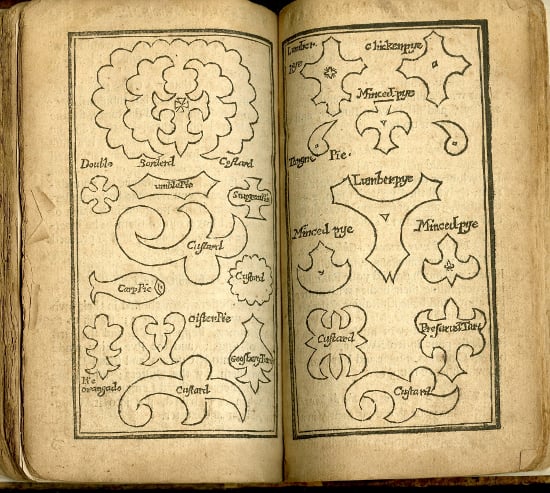
A few years ago I picked up a banged-up copy of The Accomplished Ladies Rich Closet of Rarities (the second edition, London, 1687). Why? Because it had two pages of the most amazing pie shapes I had ever seen — all put forward with no (and as if they required no) explanation.
These same pie shapes, I’ve discovered, had been passed around for a few decades, by that point — having appeared in a few different cookbooks.
They first appeared in Robert May’s The Accomplisht Cook, or the Art and Mystery of Cookery (1660), which pictured these and a few other similarly shaped pies with a similar lack of explanation. Which is odd, because — beyond the carp pie looking like a fish, the tongue pie (maybe) looking like a tongue, and the oyster pie looking like an oyster (if you are a crazy person) — there seems to be no real relationship, here, between form and filling.
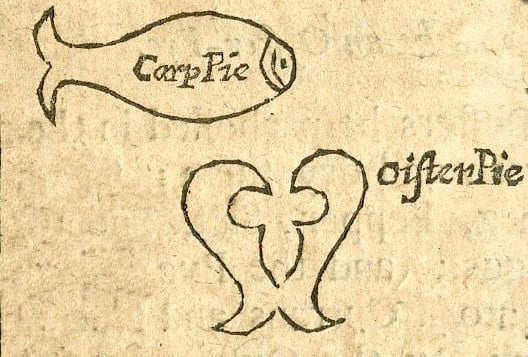
The custard pies are especially all over the place. One element, naturally, was decorative, but the profusion of strange, sweeping shapes evokes something familiar, but what?
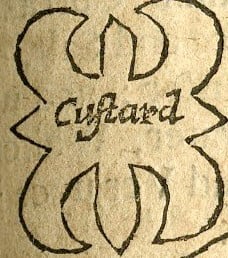
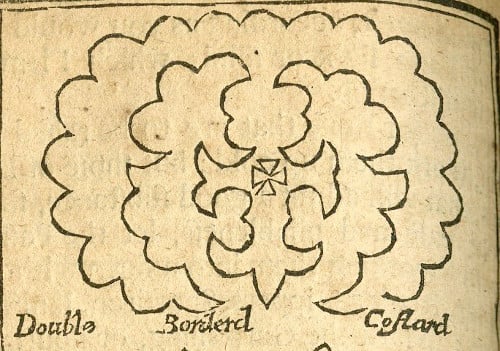
Why did mid-17th century pies take on such fantastical shapes? Let’s investigate.
One popular explanation has to do with the most commonly found weird-shaped pie: mince. It was illegal to have mince pies for Christmas, according to legend; as a result, mince pies were fashioned in outlandish shapes — i.e., in order to evade detection.

Another in a long line of nonsensical food stories, you might think. However, this one has at least a grain of truth. In 1657, Oliver Cromwell did make it illegal to eat mince-meat pies at Christmastime — as part of his puritanical campaign against gluttony. (He also outlawed Christmas, hilarity, and being Irish.) This was towards the end of Cromwell’s run as Lord Protector, eight years after relieving Charles I of his head — and just a year before he succumbed to a potent combination of malaria, kidney stones, and black bile imbalance.

Still, Cromwell’s anti-pie laws were never broadly enforced — and, in any case, did not survive into the reign of Charles I, during which time Robert May published The Accomplisht Cook. (Hilariously, banning Christmas and mince pies did catch on in puritan New England; the ban remained in Boston until 1681.) And even if glutton-pies were verboten, wouldn’t you disguise them as something other than… a pie? No officer, that’s not a mincemeat pie, it’s a playfully shaped sawdust pie! We make them fresh and then leave them out all week to make sure they are extra terrible. Have one for the road?
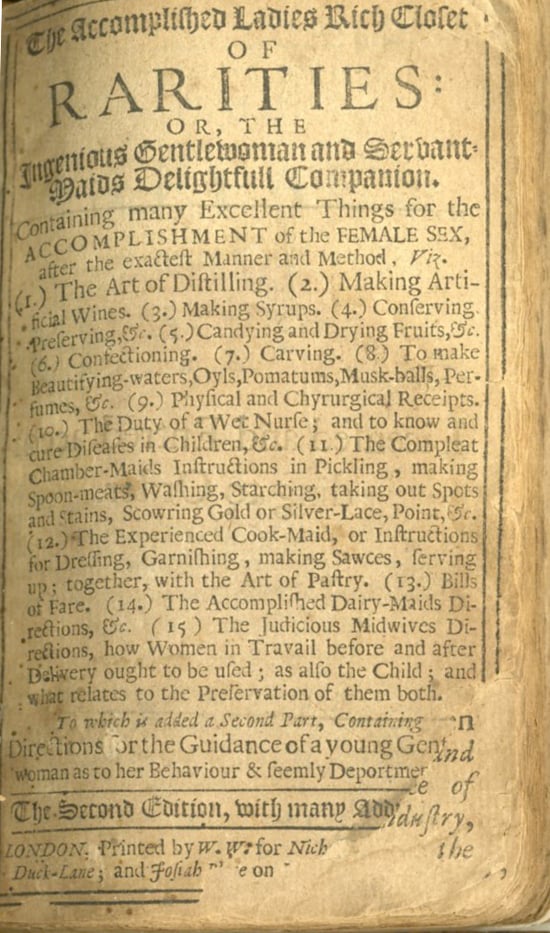
Alas, the historical record provides no answers to curious pie-shape question. Although it does reveal that, for a variety of reasons involving not only cultural traditions but economics, 17th century pies were typically cooked free-standing — i.e., not in pie tins. Hmm. I contacted Hilobrow friend and contributor Deb Chachra, who happens to be an engineering professor, for some insights.
According to Dr. Chachra:
Why are the shapes of the pies so fabulously baroque compared to today’s plain round or square pies? One reason might be to help provide structural integrity to a high-walled pie that wasn’t baked in a supporting tin. Thin walls tend to buckle or fall over when they’re flat; adding an angle or a curve makes them much more stable. (You can see this by trying to balance a piece of paper on its edge, then folding it in half and trying it again.) Especially in the larger pies, having scalloped or sharply curved edges would make the pie walls more stable without having to use a thicker crust. The same principle can be seen in crinkle crankle walls, serpentine walls that are usually only one brick wide — the alternating curves means that the wall can be made very thin, while still not falling over (and thus use fewer bricks). Of course, using different patterns of curves and angles for each type of pie may also help differentiate the contents, and would also provide different ratios of crust to filling for different kinds of pies.
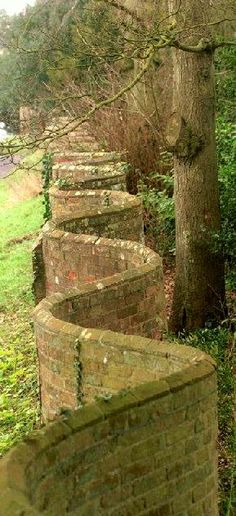
Aha! Although our natural assumption is that the fantastic shapes of 17th-century pies were motivated by aesthetics, in fact these shapes apparently evolved in parallel with the crinkle crankle walls built by Dutch engineers in swampy [nothing swampier than a custard filling!] areas of East Anglia in the 17th century. Free-standing pie walls were collapsing, but the bakers wanted to keep the exterior walls thin and delicate (no one wants an inedible crust on a custard pie — you might as well just have some custard), thus: a fantastic-looking, but entirely functional solution to our mystery.
Did crinkle crankle walls directly influence the design of pies, or vice versa? Inquiring minds want to know. If you have evidence, readers, please forward it along. — eds.
STUFFED SERIES: THE MAGAZINE OF TASTE | AUGURIES AND PIGNOSTICATIONS | THE CATSUP WAR | CAVEAT CONDIMENTOR | CURRIE CONDIMENTO | POTATO CHIPS AND DEMOCRACY | PIE SHAPES | WHEY AND WHEY NOT | PINK LEMONADE | EUREKA! MICROWAVES | CULINARY ILLUSIONS | AD SALSA PER ASPERA | THE WAR ON MOLE | ALMONDS: NO JOY | GARNISHED | REVUE DES MENUS | REVUE DES MENUS (DEUX) | WORCESTERSHIRE SAUCE | THE THICKENING | TRUMPED | CHILES EN MOVIMIENTO | THE GREAT EATER OF KENT | GETTING MEDIEVAL WITH CHEF WATSON | KETCHUP & DIJON | TRY THE SCROD | MOCK VENISON | THE ROMANCE OF BUTCHERY | I CAN HAZ YOUR TACOS | STUFFED TURKEY | BREAKING GINGERBREAD | WHO ATE WHO? | LAYING IT ON THICK | MAYO MIXTURES | MUSICAL TASTE | ELECTRIFIED BREADCRUMBS | DANCE DANCE REVOLUTION | THE ISLAND OF LOST CONDIMENTS | FLASH THE HASH | BRUNSWICK STEW: B.S. | FLASH THE HASH, pt. 2 | THE ARK OF THE CONDIMENT | SQUEEZED OUT | SOUP v. SANDWICH | UNNATURAL SELECTION | HI YO, COLLOIDAL SILVER | PROTEIN IN MOTION | GOOD RIDDANCE TO RESTAURANTS.
MORE POSTS BY TOM NEALON: Salsa Mahonesa and the Seven Years War, Golden Apples, Crimson Stew, Diagram of Condiments vs. Sauces, etc., and his De Condimentis series (Fish Sauce | Hot Sauce | Vinegar | Drunken Vinegar | Balsamic Vinegar | Food History | Barbecue Sauce | Butter | Mustard | Sour Cream | Maple Syrup | Salad Dressing | Gravy) — are among the most popular we’ve ever published here at HILOBROW.
